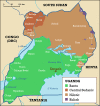HIV prevalence by ethnic group covaries with prevalence of herpes simplex virus-2 and high-risk sex in Uganda: An ecological study
- PMID: 29617423
- PMCID: PMC5884562
- DOI: 10.1371/journal.pone.0195431
HIV prevalence by ethnic group covaries with prevalence of herpes simplex virus-2 and high-risk sex in Uganda: An ecological study
Abstract
Background: HIV prevalence varies from 1.7% to 14.8% between ethnic groups in Uganda. Understanding the factors responsible for this heterogeneity in HIV spread may guide prevention efforts.
Methods: We evaluated the relationship between HIV prevalence by ethnic group and a range of risk factors as well as the prevalence of herpes simplex virus-2 (HSV-2), syphilis and symptomatic STIs in the 2004/2005 Uganda HIV/AIDS Sero-Behavioural Survey-a two stage, nationally representative, population based survey of 15-59-year-olds. Spearman's correlation was used to assess the relationship between HIV prevalence and each variable.
Results: There was a positive association between HIV prevalence and HSV-2, symptomatic STIs and high-risk sex (sex with a non-cohabiting, non-marital partner) for women. Non-significant positive associations were present between HIV and high-risk sex for men and lifetime number of partners for men and women.
Conclusion: Variation in sexual behavior may contribute to the variations in HIV, HSV-2 and other STI prevalence by ethnic group in Uganda. Further work is necessary to delineate which combinations of risk factors determine differential STI spread in Uganda.
Conflict of interest statement
Figures



Similar articles
-
Determinants of generalized herpes simplex virus-2 epidemics: the role of sexual partner concurrency.Int J STD AIDS. 2013 May;24(5):375-82. doi: 10.1177/0956462412472816. Epub 2013 Jun 14. Int J STD AIDS. 2013. PMID: 23970705
-
HIV transmission risk behavior among HIV-infected adults in Uganda: results of a nationally representative survey.AIDS. 2008 Mar 12;22(5):617-24. doi: 10.1097/QAD.0b013e3282f56b53. AIDS. 2008. PMID: 18317003
-
Sero-prevalence of herpes simplex type 2 virus (HSV-2) and HIV infection in Kampala, Uganda.Afr Health Sci. 2014 Dec;14(4):782-9. doi: 10.4314/ahs.v14i4.2. Afr Health Sci. 2014. PMID: 25834483 Free PMC article.
-
Association of herpes simplex virus type 2 infection and syphilis with human immunodeficiency virus infection among men who have sex with men in Peru.J Infect Dis. 2006 Nov 15;194(10):1459-66. doi: 10.1086/508548. Epub 2006 Oct 10. J Infect Dis. 2006. PMID: 17054077
-
Prevalence of herpes simplex virus type 2 infection, human immunodeficiency virus/herpes simplex virus type 2 coinfection, and associated risk factors in a national, population-based survey in Kenya.Sex Transm Dis. 2011 Nov;38(11):1059-66. doi: 10.1097/OLQ.0b013e31822e60b6. Sex Transm Dis. 2011. PMID: 21992985
Cited by
-
A review of authorship in herpes simplex virus type-2 (HSV-2) research conducted in low-income and middle-income countries between 2000 and 2020.BMJ Glob Health. 2024 Jul 4;9(7):e012719. doi: 10.1136/bmjgh-2023-012719. BMJ Glob Health. 2024. PMID: 38964883 Free PMC article. Review.
-
Implicit attitudes to sexual partner concurrency vary by sexual orientation but not by gender-A cross sectional study of Belgian students.PLoS One. 2018 May 8;13(5):e0196821. doi: 10.1371/journal.pone.0196821. eCollection 2018. PLoS One. 2018. PMID: 29738541 Free PMC article.
References
-
- Morris M, Kurth AE, Hamilton DT, Moody J, Wakefield S. Concurrent partnerships and HIV prevalence disparities by race: linking science and public health practice. Am J Public Health. 2009;99(6):1023–31. Epub 2009/04/18. doi: AJPH.2008.147835 [pii]. doi: 10.2105/AJPH.2008.147835 . - DOI - PMC - PubMed
-
- Aral SO, Holmes KK, Padian NS, Cates W Jr. Overview: individual and population approaches to the epidemiology and prevention of sexually transmitted diseases and human immunodeficiency virus infection. J Infect Dis. 1996;174 Suppl 2:S127–33. Epub 1996/10/01. . - PubMed
-
- Aral SO, Padian NS, Holmes KK. Advances in multilevel approaches to understanding the epidemiology and prevention of sexually transmitted infections and HIV: an overview. J Infect Dis. 2005;191 Suppl 1:S1–6. Epub 2005/01/01. doi: JID32717 [pii] doi: 10.1086/425290 . - DOI - PubMed
-
- Kenyon C, Colebunders R. Strong association between point-concurrency and national peak HIV prevalence. Int J Infect Dis. 2012;16(11):e826–7. Epub 2012/07/07. doi: 10.1016/j.ijid.2012.05.008 . - DOI - PubMed
-
- Morris M, Goodreau S, Moody J. Sexual networks, concurrency and STD/HIV In: Holmes KK, editor. Sexually transmitted diseases. 4th ed New York: McGraw-Hill Medical; 2008. p. xxv, 2166 p.
MeSH terms
LinkOut - more resources
Full Text Sources
Other Literature Sources
Medical

